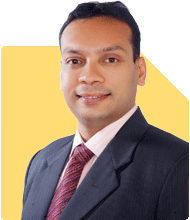Ramalingam Kalirajan |6501 Answers |Ask -Follow
Mutual Funds, Financial Planning Expert - Answered on Jul 06, 2024
He has an MBA in finance from the University of Madras and is a certified financial planner.
He is the director and chief financial planner at Holistic Investment, a Chennai-based firm that offers financial planning and wealth management advice.... more

Monthly income of me and my wife combined would be around 1 lac...expenses+emi monthly would be around 50 k ...Savings would be around 45 lacs and we both are 39.Need to save atleast 3 cr by the age of 50 to retire ...we live in Guwahati....Kindly suggest how to achieve the planned figure
Your goal is to save Rs. 3 crores by the age of 50, and you currently have Rs. 45 lakhs in savings. Let’s break down a comprehensive plan to achieve your target.
Understanding Your Financial Landscape
Your combined monthly income is Rs. 1 lakh.
Monthly expenses and EMIs are Rs. 50k.
Current savings amount to Rs. 45 lakhs.
You both are 39 years old and aim to save Rs. 3 crores by age 50.
Living in Guwahati, you have 11 years to achieve this goal. Now, let's discuss how to reach this target.
Setting Financial Goals
Setting clear financial goals is crucial. You aim to accumulate Rs. 3 crores in 11 years, which requires disciplined saving and investing.
Evaluating Investment Options
Mutual Funds
Mutual funds are a strong option for long-term wealth creation. They offer diversification, professional management, and the power of compounding.
Types of Mutual Funds:
Equity Funds: Invest in stocks for high returns but higher risks.
Debt Funds: Invest in fixed-income securities for moderate returns with lower risks.
Hybrid Funds: Combine equity and debt for balanced risk and return.
Advantages of Mutual Funds
Diversification: Reduces risk by spreading investments across various assets.
Professional Management: Experts manage the funds, aiming for maximum returns.
Liquidity: Easy to buy and sell as per your needs.
Compounding: Reinvesting earnings leads to exponential growth over time.
The Power of Compounding
Compounding is earning returns on your returns. It’s a powerful tool for growing your investment over time. Starting early and investing regularly will significantly increase your wealth.
Disadvantages of Index Funds
Index funds are low-cost funds that track market indices, but they have limitations.
Limited Returns: They only match market performance, no potential for higher returns.
No Active Management: Lack flexibility to capitalize on market opportunities.
Benefits of Actively Managed Funds
Actively managed funds have experts making investment decisions to outperform the market.
Potential for Higher Returns: Fund managers can exploit market inefficiencies.
Risk Management: Active monitoring and adjustment based on market conditions.
Disadvantages of Direct Funds
Direct funds require investors to manage their investments themselves.
Complexity: Requires knowledge and time to manage.
Risk: Higher risk if not managed well.
Benefits of Regular Funds Through CFP
Investing through a Certified Financial Planner (CFP) offers guidance and expertise.
Professional Advice: Get tailored investment strategies based on your goals.
Regular Monitoring: Ensures your investments are on track.
Systematic Investment Plan (SIP)
Start a SIP in diversified mutual funds. SIPs help in disciplined investing and reduce the impact of market volatility.
Emergency Fund
An emergency fund is essential. It should cover 6-12 months of expenses. This ensures you are prepared for unexpected situations without disturbing your investments.
Assessing Your Goals
Given your situation, let’s assess your financial goals:
Retirement Planning: Your primary goal is to accumulate Rs. 3 crores by age 50. This requires disciplined investing and regular monitoring.
Children’s Education: If you have children, consider starting a fund for their education. Long-term investments will help build a significant corpus.
Healthcare: Plan for healthcare expenses by investing in a health insurance policy. This will cover unexpected medical costs.
Investment Strategy
Systematic Investment Plan (SIP)
Start a SIP in diversified mutual funds. This ensures disciplined and regular investing.
Diversification
Diversify your investments across equity, debt, and hybrid funds based on your risk appetite and time horizon.
Reviewing Your Investments
Regularly review your investments and make adjustments as needed. Consulting with a Certified Financial Planner ensures your investments align with your goals and risk profile.
Empathy and Encouragement
Your commitment to securing your family’s future is commendable. Starting now with a disciplined investment approach will help you achieve your financial goals.
Long-Term Investment Plan
To achieve your goal of Rs. 3 crores, you need to invest regularly and wisely. Here’s a detailed plan:
Monthly Investments
With a monthly surplus of Rs. 50k, you can start a SIP in diversified mutual funds.
Equity Funds: Allocate a portion to equity funds for high returns.
Debt Funds: Allocate a portion to debt funds for stability and moderate returns.
Hybrid Funds: Allocate a portion to hybrid funds for balanced risk and return.
Annual Bonus
Invest your annual bonus of Rs. 10 lakhs in mutual funds. This will significantly boost your investment corpus.
Reviewing and Adjusting
Regularly review your investments and adjust your portfolio based on market conditions and your financial goals.
Additional Considerations
Life Insurance: Ensure you have adequate life insurance coverage to protect your family.
Health Insurance: Invest in a good health insurance policy to cover medical expenses.
Tax Planning: Invest in tax-saving instruments to reduce your tax liability and increase your savings.
Final Insights
To achieve your goal of Rs. 3 crores by age 50, focus on disciplined investing in mutual funds. They offer high returns, diversification, and professional management, crucial for long-term wealth creation.
Avoid direct funds due to complexity and risk. Invest through a Certified Financial Planner for expert guidance. Regularly review and adjust your investments to stay on track.
Your financial journey is unique, and with careful planning and execution, you can achieve your goals. Start now, invest wisely, and secure your financial future.
Best Regards,
K. Ramalingam, MBA, CFP,
Chief Financial Planner,
www.holisticinvestment.in
You may like to see similar questions and answers below
Ramalingam Kalirajan |6501 Answers |Ask -Follow
Mutual Funds, Financial Planning Expert - Answered on May 26, 2024
Ramalingam Kalirajan |6501 Answers |Ask -Follow
Mutual Funds, Financial Planning Expert - Answered on Jun 25, 2024
Ramalingam Kalirajan |6501 Answers |Ask -Follow
Mutual Funds, Financial Planning Expert - Answered on Jul 27, 2024
Ramalingam Kalirajan |6501 Answers |Ask -Follow
Mutual Funds, Financial Planning Expert - Answered on Sep 09, 2024
Dr Dipankar Dutta |653 Answers |Ask -Follow
Tech Careers and Skill Development Expert - Answered on Oct 04, 2024
Krishna Kumar |377 Answers |Ask -Follow
Workplace Expert - Answered on Oct 04, 2024
Krishna Kumar |377 Answers |Ask -Follow
Workplace Expert - Answered on Oct 04, 2024
Krishna Kumar |377 Answers |Ask -Follow
Workplace Expert - Answered on Oct 04, 2024
Krishna Kumar |377 Answers |Ask -Follow
Workplace Expert - Answered on Oct 04, 2024
Krishna Kumar |377 Answers |Ask -Follow
Workplace Expert - Answered on Oct 04, 2024
Krishna Kumar |377 Answers |Ask -Follow
Workplace Expert - Answered on Oct 04, 2024
Krishna Kumar |377 Answers |Ask -Follow
Workplace Expert - Answered on Oct 04, 2024
Krishna Kumar |377 Answers |Ask -Follow
Workplace Expert - Answered on Oct 04, 2024
Krishna Kumar |377 Answers |Ask -Follow
Workplace Expert - Answered on Oct 04, 2024























